Alaska Science Camps, Fairs & Experiments
ANKN is a resource for compiling and exchanging information
related to Alaska Native knowledge systems and ways of knowing. We
are pleased to create and distribute a variety of publications
that assist Native people, government agencies,
educators and the general public in gaining access to the knowledge
base that Alaska Natives have acquired through cumulative experience
over millennia.
TO ORDER THIS PUBLICATION:
Contact the ANKN
offices at 907-474-1902 or email uaf-cxcs@alaska.edu.  Spruce & Spruce &
 Other
Roots Other
Roots
There are many traditional uses for spruce
roots: birch baskets, canoes, fish traps, a variety of lashings and
even whole baskets made of woven roots.
Location
Look for a patch of smaller spruce trees 10-20' tall. They might
even be among cottonwoods. The roots on very large spruce trees are
often too deep to dig easily.
You can tell the quality and nature of the roots by the tree
itself:
|
- If the branches are brittle, the roots will be
brittle and easy to break. Test the branches to see if
the roots are strong.
- If the tree has many branches like a Christmas tree,
then the roots will tend to be short with many small
branches. If the trunk of the tree is long and slim, the
roots will tend to be the same way.
- If the roots are too deep they are hard to dig.
- If you can't tell spruce roots from cottonwood or
other roots as they are entangled with each other in the
soil, smell or taste them. They have the same distinct
smell as the needles, branches, and bark of the spruce
tree.
|

|
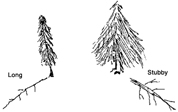
|
Oldtimers used a stick to dig roots.
Nowadays we use a carpenter 's framing hammer.

DIGGING STICK
Test the trees, then test the roots. Do you notice a connection
between the toughness of the branches and the toughness of the
roots?
Is there a connection between the configuration of the tree trunk
and its roots? (Long vs. stubby with many branches)
 Try
gathering roots with your hands, then Try
gathering roots with your hands, then- Make a stick like the oldtimers.
- Try a framing hammer. Which method do you prefer? Some people
gather the roots exposed on cutbanks. This is a very easy method,
but the roots are too dry to clean unless gathered right after
being exposed.
Cleaning the Roots
Cleaning the bark from the roots is easy or hard, depending on
when they are gathered. If it is June or July, the bark comes off
quite easily. Before or after June/July they peel with more
difficulty, although cleaning is never the hardest part of the job.
Digging the roots is the difficult part
|
1. Oldtimers used to chop a tree down that was
2"-3" in
diameter, leaving the stump at least 12-18" above the
ground. They split the stump with an axe, and cleaned the
roots by pulling them through the crack in the stump. This
works quite well, but the crack tends to plug requiring
frequent cleaning.
|
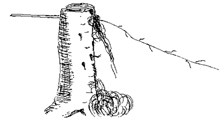
|
|
2. Another method is to split a stick, and tie the two
pieces together on one end. Holding the stick together while
the spruce roots are pulled between them cleans the bark
from the roots. It is easy to clean the bark from the crack
in the stick.
|
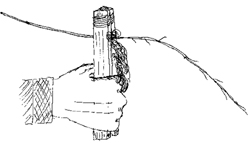
|
|
3. Nowadays we pull the roots between the claws on a
framing hammer. The bark peels easily from the roots. This
seems to be the best method, as it cleans the roots quickly
and is itself easy to clean. We use the same hammer to dig
the roots. It is a two-in-one tool.
|
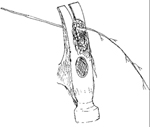
|
.
Try cleaning roots gathered before, during, and after the
June-July season. Is the difference noticeable?
Try the above three methods of cleaning roots. Which do
you
prefer?
Willow and Cottonwood roots
Cottonwood roots look good, but after they dry, the break
by
themselves. You can hear the popping noise as your basket comes
apart.
Willow roots are often good, but there are many different kinds of
willows.
They can be gathered by pulling up willows on a sandbar,
or
collecting them as they hang from cutbanks. The only way to find a
good place for roots is to try many different locations. Some are
long, some short. Some are tough and some break easily.
 Splitting Splitting
Once the roots are gathered and cleaned, they also need to be
split, as one end is thick and the other thin. The roots often have a
natural indentation. Start the split there.
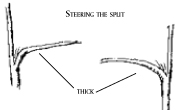 Split
the root down the middle as accurately as possible. When one side
gets thicker than the other , bend the thick one. The stress on it
will cause the fibers to split over towards the thinner side. The
split is "steered" by bending or holding straight the both sides of
the split. We usually hold one side of the split in our teeth. We
split by feeling the roots, as it is hard to see what is going on.
The rule is "Stress the fat one." Split
the root down the middle as accurately as possible. When one side
gets thicker than the other , bend the thick one. The stress on it
will cause the fibers to split over towards the thinner side. The
split is "steered" by bending or holding straight the both sides of
the split. We usually hold one side of the split in our teeth. We
split by feeling the roots, as it is hard to see what is going on.
The rule is "Stress the fat one."
How thick or thin they need to be depends on the use. When we
split a root into fourths, we do as shown on the left, not as on the
right.
|

|
|
YES
|
NO
|
Splitting willow branches is ver y similar to splitting spruce
roots. We often let young people practice on willow branches as they
are much easier to gather. Once they have mastered splitting, we let
them do roots.
Some people split the roots first and then clean the bark
from them by scraping with a knife. Try both methods:
1. clean then split, or
2. split then clean. Which is easier?
Compare the strength of spruce roots to those of willow and
cottonwood. Do several tests with roots of similar size. In the past,
people from different villages traded with each other. You might have
to trade with other villages too.
 Compare
the strongest of these with modern materials like nylon and cotton.
We split the straps used to wrap our groceries and use them for
lashing. They split very easily and are incredibly tough. Compare
the strongest of these with modern materials like nylon and cotton.
We split the straps used to wrap our groceries and use them for
lashing. They split very easily and are incredibly tough.
Storing
We usually store roots coiled in small plastic bags in the
refrigerator or freezer. This keeps them from drying out, although
dry roots can be soaked in water and restored.
Knots
Bending the fibers in roots greatly weakens them. All knots and
lashing should be done in a way that bends the fibers as little as
possible.
|

|
|
GENTLE
BEND
|
SHARP BEND
|
Ask the Elders which knots were used for different applications.
Experiment with different knots in those applications. Which knots
work best for you?
Planning ahead
It is impossible to get roots in wintertime. The wise basketmaker
gets an adequate supply in the summer and fall. That is wealth.
|